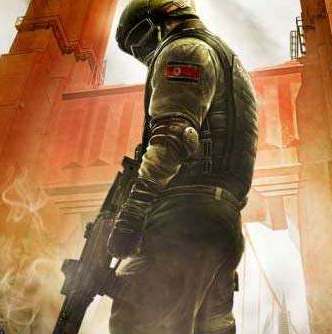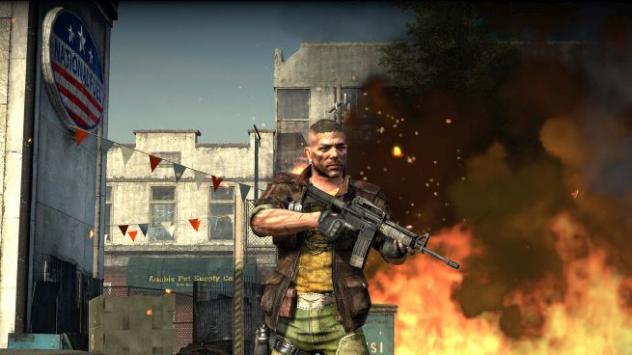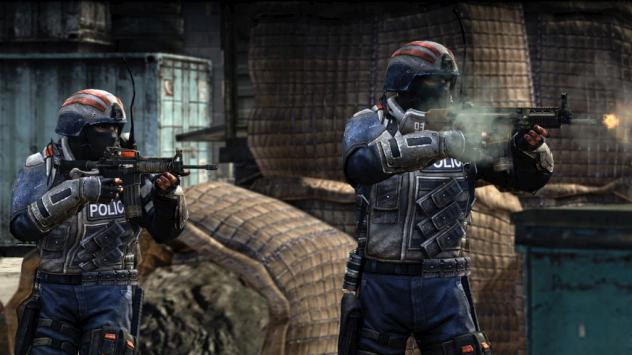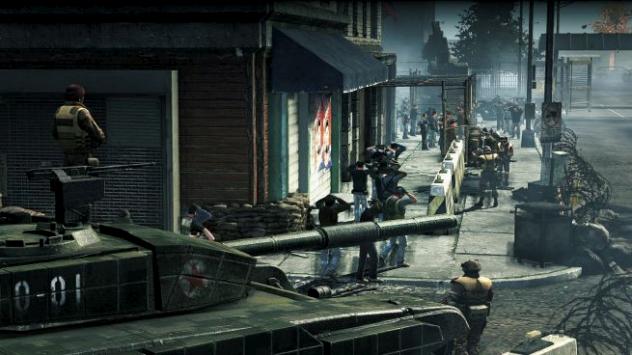
THQ have made a big deal about Homefront. The latest title from Kaos has had a massive build up, had its choice of storyline criticised and praised in equal measures and even tried to entice gamers deeper into the storyline with the Voice of Freedom novel. Early reviews have been massively varied, more so than pretty much any other game of this generation, so when I sat down with Homefront I had a determination to give it time, not rush the review, and take the game for what it is in its own right. One thing you won’t see in the following write-up is a comparison to other FPS titles – Kaos have done enough to ensure Homefront should be looked at as a seperate entity, so that’s the treatment it’ll get. Whether it repaid us for this will be revealed over the following few paragraphs…
A large Korean Republic invading and occupying America doesn’t seem like a good theme for a game that’s got its sights on realism. But as we revealed in our Voice of Freedom review, the timeline put in place follows a sequence of events which in their own right were relatively feasible – these events are played out in the game’s introductory video, although the speed the events are reported at means it’s very possible you’ll start the game not really knowing what’s going on. Everything becomes clear enough eventually, especially if you manage to collect a decent number of the newspapers that are scattered throughout the game, but with a story as deep and historically important as this it would have been nice to have had the option to find out more about why you’re in the position you’re in. If you’ve read the Voice of Freedom you’ll be up and running before you’ve even put the disk in the drive, but as most people won’t have done it could be a little confusing initially.
But you most certainly get the gist of what’s going on during a bus journey shortly after the game starts. Having been captured by the Koreans, you’re being transported to another area of town through busy streets lined by captured families, people being herded into rows and Korean soldiers patrolling the pavements. As you talk to another captured passenger you’re free to look around and see the horror of what’s unfolding. If Kaos wanted to get some shock value into Homefront, then you don’t need to wait long. One of the most eye-widening moments I’ve seen in a video game takes place right in front of your eyes, as a Korean soldier guns down an innocent young kid’s parents for no apparent reason, leaving the kid crying and screaming over their lifeless corpses. The fact you don’t get a chance to stop it or fight back instantly certainly gets the adreniline flowing, and after an unexpected but welcome rescue attempt frees you from the bus you jump seamlessly into the action. And it’s intense.

As soon as you escape the bus you’re getting shot at. Finding cover (and a weapon) is essential, and while the opening few moments serve as a tutorial of sorts to talk you through the main controls you still need to keep your eyes open. Once the brief honeymoon period is over the feeling that you’re outnumbered and out-gunned is all too apparent. Over the next few hours you’ll encounter huge numbers of Koreans (and a few slightly screwed up Americans) and as part of a small resistance cell you’ll need to keep your wits about you and maintain your accuracy if you’ve any hope of getting from A to B in one piece. You’ll use a wide range of weapons throughout the battle, picking up anything you find that suit your purpose. Each weapon feels solid enough when you use them, and whether you’re using an M4 or an RPG you’ll get the feeling you’re handling a fairly heavy duty piece of kit. Similarly, when you get hit you know you’re in trouble. You’ll feel your heartbeat through the controller and see your own blood in front of your eyes, and if you don’t find somewhere safe to hide you can expect to see the world fading away a few seconds later. Pretty common fare for this type of game possibly, but mixed with the intensity and brutality of the battles it grabs you by the face and pulls you firmly into the experience with no intention of letting go, and once you get hold of the controls for Goliath – an automated war machine with heavy armour and a powerful array of weaponary – you’ll be causing more explosions than your average fireworks convention.
If you thought the shock factor stopped at the shooting of a little kid’s parents, you’d be very wrong. Several points through the game have the potential to make you feel extremely uncomfortable, whether it’s seeing a fellow American being hung from a bridge or having to jump into a mass grave to avoid being seen by Korean patrols. It would be easy to see this as Kaos going over the top to get some attention, but I don’t see it that way. You’re fighting a brutal invading force who have no desire to play nicely or fairly – to go through the game without ever seeing a nasty event wouldn’t match the storyline in any shape or form. These moments generally come at such a point to either give you a breather after a heavy duty fight, or to get you and your comrades psyched up before more Koreans turn up, although the fantastic Firesale level gives you intense fighting and fairly shocking surroundings at the same time, just to keep things up-tempo.
As a single player campaign Homefront is an exciting and hard hitting experience. The basis of the story coupled with the hugely enjoyable battles mean that while it lasts you’ve got a lot of bullets to fire and lot of fun to be had doing so, and fighting through run down towns feels far more satisfying than being randomly dropped in the middle of a wide open desert. There are admittedly a couple of elements that could have been more polished; getting through doors at the same time as someone else is tricky due to a strange invisible box around each character that seems to be slightly too big, something that can get in the way if you’re trying to squeeze through a fairly small gap to advance further. And the length of the campaign can’t be ignored – it would be nice if it were a little longer, although being a FPS game you’d have to question how many people will buy this solely for the single player game. I suspect a survey of FPS fans would suggest that the vast majority buy a shooter to play online, so I won’t harp on about the length of the campaign. It’s fun, it’s powerful and it’s very tough on a harder setting; plenty to go back to after you’ve had an initial run through.

But, as suggested above, most people will buy Homefront for its online play, and those people are in for quite a treat. While the options available appear initially limited with just 6 maps and three game modes, it’s the way the online games work that make it such an addictive piece of work. Initially available are Team Deathmatch, allowing up to 24 players divided into two teams to go head to head and blast the blazes out of each other for nothing other than pride, and Ground Control (cue a David Bowie sing-along) which brings 32 players into the arena to try and capture various points of the map and keep them long enough to build up the team’s score. On top of this is Skirmish, giving smaller 16 player battles and mixing up the 2 aforementioned modes to give a bit of variety. So nothing really new here, or at least not until you level up a bit.
After a few hours of play you’ll unlock Battle Commander mode. Here, the leading players on the other team are highlighted for you to see more clearly. These players who are clearly a much more dangerous opponent will earn you extra points for killing them, so do you head in their direction to try and gain a few extra battle points or use your knowledge of their position to stay well clear and pick off a few easier kills? That’s your call, and one that isn’t easy to make. It’s a fantastic addition to the multiplayer, and if you get a few kills together you’ll be very conscious that you’re position is as known to the enemy as if you were carrying your own personal flare with you.
Any kills or objectives that you achieve earn you battle points. While these bonuses go towards your ranking up, they also play a key part in how your round unfolds. Each class that you can choose from has purchasable upgrades or weapons that you can buy at any stage in the round as long as you have enough battle points. These bonuses, which range from body armour through to recon drones and guided missiles, are a single button press away. 3 or 4 enemies camping on a capture point? Send in a missile to clear them out. Need a bit more firepower to clear a path for your team? Well you’ll be wanting to spawn into your own tank then and blow some bad guys away. Not everything is available immediately, and some ranking up is required to get the combination that you might want, but that just encourages you to keep plugging away. It’s a great system; better players will save the points until later in the round to give them the chance of getting one of the beefier weapons, but if you fancy launching your own personal UAV the second the round begins in exchange for most of your starting pot of points, then the option is there for you to take.

Other customisable elements are the infantry abilities, giving you a set number of points to spend on personal upgrades which allow you to reload faster, keep your drones flying for longer and so on. With elements costing varying amounts of points there are several combinations available and as long as you don’t overspend you can have several lower cost extras or use less high-end upgrades. Again, it’s up to you. But all of this customisation wouldn’t be any good if you got into a game and had so fun at all. Luckily, that’s not going to be a problem with Homefront.
The maps are a great mix of open spaces and cluttered buildings, giving both snipers and shotgun fans somewhere to play happily. Killing someone is extremely satisfying, and when you get killed yourself it’s pretty much always your own fault. I’ve played a fair amount of Homefront online and I’ve never had that frustrating feeling that I’ve been unfairly shot – any annoyance is aimed at myself and my lack of ability to get out of the way properly. Some people have found snipers a frustration, suggesting they’re ruining the game. But in my experiences Kaos have done a great job to combat camping snipers, and there are many ways you can get your own back by spending your battle points wisely. Find them with a Parrot drone to highlight their position to the rest of your team, send a mini attack helicopter their way and give them hell, or just go totally over the top and send a guided missile or two at them. There are no safe spots, nowhere to totally hide. Every tactic has a flaw, and every style of playing has a counter-syle that tears it to pieces. Games are close, and fighting to the very end is essential if you want to win.
With everything considered, I can accept that Homefront isn’t perfect. I can accept that the single player campaign isn’t the longest, and the graphics aren’t going to win any awards. But what I struggle to accept is that these are reasons to totally ignore Homefront in favour of other FPS games. Every review is an opinion, one person’s view on a game, and for me Homefront is very nearly everything it promised to be. I loved the single player campaign, the shocking scenes throughout and the way they drove the story on to give you a determination that doesn’t happen all that often in a video game. The multiplayer is one of the finest and most addictive experiences I’ve played in a fair while, and once THQ iron out the server issues that have caused a few problems then it’ll be a robust and hugely fun online title.
Homefront isn’t perfect, but it’s still a great game, and one that fully deserves to be given a chance. Get yourself a copy; I’ll meet you outside Hooters with my M4.


I pretty much agree with what has been said. The SP is too short, but that isn’t why I bought the game. I bought it for the online mode, and whilst they could have put a few more maps in, I am thoroughly enjoying it.
They seem to be improving the servers on the back end, so the lag that was apparent on release day/weekend is disappearing and the hit detection is getting better because of that.
The Battle Commander mode is interesting and a good idea.
Overall I think 8 is a fair score. I am sure it would have got better reviews had it had more polished graphics and a longer SP game.
Nice to see a review that doesn’t keep going on about why it’s rubbish for not being COD, or knocking off stupid points for the single player game being too short.
This has convinced me to buy it, thanks for such a genuine review.